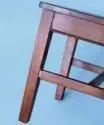Those Nasty, Nasty Nails

About the same time, however, the old hide glues originally used to hold the joints together began to lose their grip on the wood. While the major joints that were pegged held together even after the old glue had quit working, the minor joints — often those in chairs — came loose. And since Arts & Crafts furniture wasn’t then considered worthy of a proper restoration, the solution to this problem came in the form of a hammer and a nail.
Simply stated, a nail is never the preferred way to correct a loose joint. Glue is always better, for glue covers a larger surface of the wood and, unlike a nail, glue won’t act as a wedge that can split the wood under stress.
So, what do you do if your chairs are loose – but have nails in the joints?
Ideally, remove the nails without doing any damage, then reglue the joints.
The key phrase here is “without doing any damage.” Knocking a nailed joint apart with a hammer can leave dents in the wood and can cause the wood to split around the nail. Digging the nail out with a pair of blunt pliers can leave behind a small crater.
To start, inspect the nail head closely. If it protrudes even slightly, you may be able to grasp it with the tapered tip of a pair of diagonal pliers (also called wire-cutting pliers). Diagonal pliers are critical, for needle-nosed pliers lack a pointed tip and regular pliers are too blunt for delicate work.
Once you grasp the nail head with your pliers, protect the wood with a thin piece of wood to use as a fulcrum. You need leverage to coax a nail out of the wood, but you don’t want to press the metal pliers against the antique wood, for that will leave a dent you won’t be able to disguise.
Once the nails have been removed, you can then pull the joint apart, lightly sand off the remains of the old glue and reglue the joint. You can disguise the nail hole with a small amount of a tinted wood dough (get the type that does not require any sanding).
But what if the nail is countersunk below the wood?
In this case you have to make a judgment call: if removing the nail would do damage to the wood, you may have to live with it — just make sure the chair isn’t subject to any unnecessary stress.
Good Luck!
– Bruce Johnson

